Saturday, October 01, 2005
Silvered Æ antoninianus, Gallienus, Rome, Göbl 477q¹
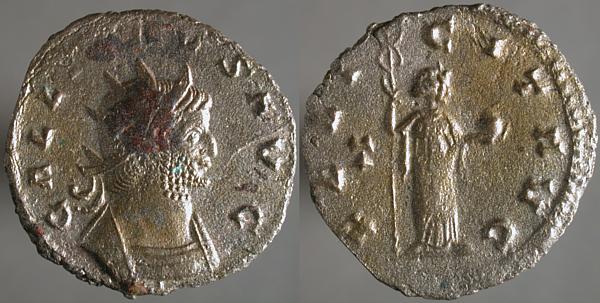
GALLIENVS AVG, Radiate cuirassed bust right | FELICIT AVG, Felicitas standing right, holding caduceus in right hand and globe in left. T in left field.
Four years ago, when I started collecting ancient coins, I knew no better so I described coins from the viewers point, so the reverse here would be "Felicitas standing facing, head right, holding caduceus left and globe right. T in left field."
The convention, though, is to describe the figure on the reverse from the figure's point of view. I don't think my old way was really wrong, but it was unexpected. I was recently asked by a real numismatist why I was doing that, and I had no good answer.
I'm not going back through two years of blog posts to fix them, but I'm busy cleaning up the main collection site and I intend that all new posts here will observe this shibboleth that I've previously resisted.
Because stubbornness will carry a person only so far.
Friday, September 30, 2005
Æ23, Antioch in Pisidia, Gallienus, Lindgren & Kovacs 1258...
var
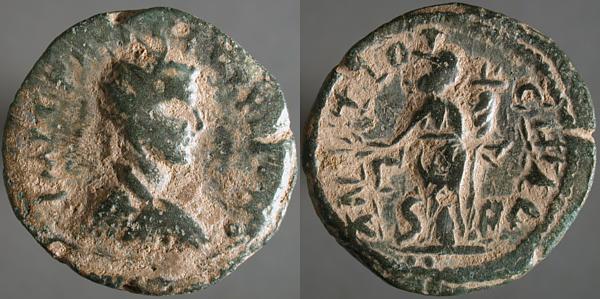
IMP C P ΛIC [...], Radiate draped cuirassed bust right | AN_TIO_CHIAE, Tyche of Antioch standing left, holding branch in right hand and cornucopia in left. Γ beneath branch, S R across lower fields, two pellets in exergue.
Unlike Tuesday's coin from this city, this seems more like Pisidian Antioch, with legends that stray a bit from Latin. I particularly like the lambda, Λ, substituted for its Roman equivalent, L.
Cities with colony status, such as this, used Latin legends on their coins, but clearly many in the city were more comfortable in Greek.

IMP C P ΛIC [...], Radiate draped cuirassed bust right | AN_TIO_CHIAE, Tyche of Antioch standing left, holding branch in right hand and cornucopia in left. Γ beneath branch, S R across lower fields, two pellets in exergue.
Unlike Tuesday's coin from this city, this seems more like Pisidian Antioch, with legends that stray a bit from Latin. I particularly like the lambda, Λ, substituted for its Roman equivalent, L.
Cities with colony status, such as this, used Latin legends on their coins, but clearly many in the city were more comfortable in Greek.
Thursday, September 29, 2005
Billon antoninianus, Gallienus, Samosata, Göbl 1685m(3)var
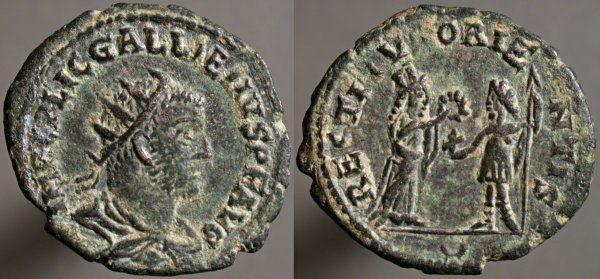
IMP C P LIC GALLIENVS P F AVG, Radiate draped cuirassed bust right | RESTITVT ORIENTIS, Tyche standing right, presenting wreath in right hand to emperor, right, who holds statue in right hand and spear in left. Two pellets in exergue.
Surprisingly similar to a coin I posted earlier this year, I now doubt my suspicion of that piece as an ancient counterfeit. This coin, from the same mint, shares the exergue with two pellets, which may mean the same workshop and same engraver, and something that may be a statue of Victory in Gallienus's right hand.
Wednesday, September 28, 2005
Æ antoninianus, Severina, Antioch, RIC 20
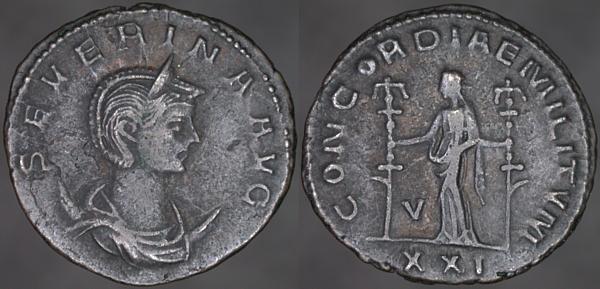
SEVERINA AVG, Draped diademed bust right on crescent | CONCORDIAE MILITVM, Concordia standing left holding an ensign in either hand. V in left field, XXI in exergue.
Some believe that Ulpia Severina, (probably) wife of Aurelian, may have briefly ruled in her own name after his death. No ancient documents support this, but the length of the interregnum between Aurelian's death in September or October 275 and the accession of Tacitus, not before November, and the common use of military themes on her coins, makes this a popular conceit.
Tuesday, September 27, 2005
Æ23, Antioch in Pisidia, Gallienus, Lindgren & Kovacs 1256...
var
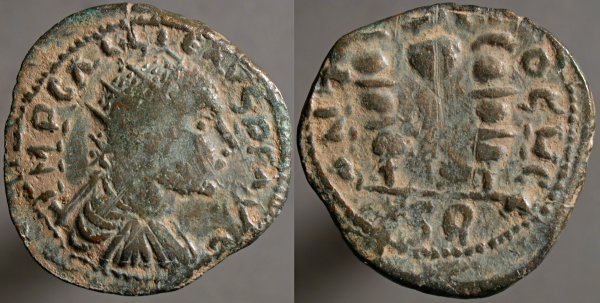
IMP GALLIENVS P F AVG, Radiate draped cuirassed bust right | ANT_[I]_OCH C, Vexillum with eagle on top between two standards. S R in exergue.
In general, the coinage of Pisidian Antioch, at this time, features legends that seem to show rote copying by illiterate engravers. This example is unusual for the well-formed legends, although the emperor's portrait is among the worst-executed I've seen.

IMP GALLIENVS P F AVG, Radiate draped cuirassed bust right | ANT_[I]_OCH C, Vexillum with eagle on top between two standards. S R in exergue.
In general, the coinage of Pisidian Antioch, at this time, features legends that seem to show rote copying by illiterate engravers. This example is unusual for the well-formed legends, although the emperor's portrait is among the worst-executed I've seen.
Monday, September 26, 2005
Silvered Æ antoninianus, Gallienus, Cyzikus, unlisted, ...
cf. Göbl 1536Ac
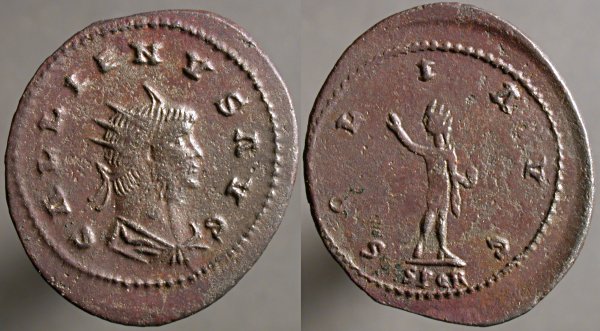
GALLIENVS AVG, Radiate draped cuirassed bust right, no pellets beneath | SOLI AVG, Radiate Sol standing right, head left, raising right hand and holding globe in left. SPQR in exergue.
Ahhh. One of the motivations for a collector is to have what no one else has. Here's one that no one else has. The reverse legend isn't known for this emperor and, as yet, I haven't found it for any emperor. (I'm guessing defective grammar.)
The studied population of Cyzikus coins is quite small but I see them in the market nearly monthly and think that the next thorough publication of Gallienus coinage will show many that I don't know about.

GALLIENVS AVG, Radiate draped cuirassed bust right, no pellets beneath | SOLI AVG, Radiate Sol standing right, head left, raising right hand and holding globe in left. SPQR in exergue.
Ahhh. One of the motivations for a collector is to have what no one else has. Here's one that no one else has. The reverse legend isn't known for this emperor and, as yet, I haven't found it for any emperor. (I'm guessing defective grammar.)
The studied population of Cyzikus coins is quite small but I see them in the market nearly monthly and think that the next thorough publication of Gallienus coinage will show many that I don't know about.
Sunday, September 25, 2005
Æ drachm, Alexandria, Salonina, Emmett 3866(12)

KOPNHΛIA CALωNEINA CEB, Diademed draped bust right | LIB, Eagle standing right, head left, wreath in beak. Palm in right field, regnal year in left.
Like last Sunday's coin, this Alexandrian drachm from the collection of Thomas Ollive Mabbott is from 264-265 and was auctioned in 1969 (it brought #17.)
Provenance, the history of who's owned a coin and where it's been, adds a bit of interest to collecting, but it's usually a poor reason to buy a coin that otherwise would have been avoided.

